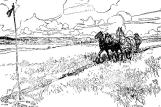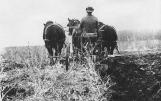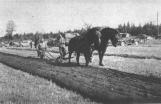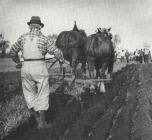14
The share or point of the plow was early made of iron or steel and mouldboard often faced with metal, a technique introduced by John Deere, and Leonard Andrus around 1837.There were several different types of plows made and patented in Eastern Ontario from the mid 1800's.
The Harris Brown plow at Ross Museum is a Fleury Scotch Thistle #53 plow manufactured by the Fleury Plow company of Aurora, north of Toronto, Ontario, Canada. This company was founded by Joseph Fleury, who set up a blacksmith shop in Aurora in 1857, forming his plow company in 1859, which became known world wide.
16
The proper adjustment of the hitch is the most important factor in the operation of horse drawn plows. The point of hitch must be on a straight line, drawn from the centre of load to the point of draft at the collar in order to have the plow run easily at the proper depth.The best way to learn how to plow is with a good experienced team and an able teamster helping and a clean field cleared of rocks. After a few rounds the novice plowman should be able to take on both the horses and the plow.
18
With riding plows, as with walking plows, a straight line from the centre of the load (draft) through the point of hitch, to the point of draft on the collar is necessary.20
When all parts of a riding plow are properly adjusted, the combined weight of the plow, teamster and the furrow being turned is carried on the wheels.21
The First Furrow by C.W Jeffreys illustrates how the first furrow was plowed when settling the land.1880

22
Plowing was important as well for the Western settlers. When settlers reached their homested on the unbroken prairie, the first job was to break enough ground to put in a crop. They would set up a tall pole with a handkerchief tied to its top and to it directed the path of the plow. Turning the horse, a parallel furrow was driven beside the first, returning to the starting point and repeating the process until sufficient ground was plowed for the purpose of planting. The plowing of the first furrow really marked the occupancy of the homestead.24
When the first settlers arrived in this area they faced the challenge of changing the tree covered landscape acre by acre to establish their farm. The plowing was a necessity for survival to provide food for their family and livestock as well as grain to sell or trade.While they worked to enlarge their acreage, communities were created providing fellowship and opportunities to share their problems.
They remembered having competed at fairs and plowing matches in their homelands and revived these old traditions by establishing local agricultural fairs and plowing matches.
26
It is believed that competitive plowing began in Scotland when two or more plowmen would compete to see who could plow the straightest furrow over a measured distance.Shortly after a farmer took up a new residence his neighbours would plow his land for him. After plowing was completed, the farmers would look over each others 'lane' and comment on their methods which led to the awarding of a prize to the best plowman, thus the beginning of competitive plowing.
In 1819 the farmers of Nova Scotia held the first matches in Canada with eight events.





